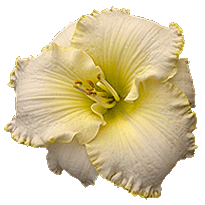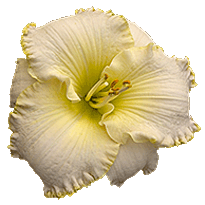




SURVIVE OR THRIVE? Daylilies will grow anywhere (well ALMOST anywhere), but if you want your plants to thrive, not just survive, then it's well worthwhile to consider the following precautions and procedures.
SUNLIGHT: Daylilies are, generally speaking, sun worshippers, performing their best with a minimum daily dose of six hours of direct sun. Having said that, some qualification is needed: Dark colors absorb the heat of the sun, light colors reflect it. This is true of daylilies as well. So consider planting those specimens whose blooms have deep, rich color in areas where they will escape the midday sun, the heat from which may cause their blooms to wilt or “slick” prematurely. Conversely, plant those daylilies whose blooms are of lighter colors where they will receive full sun to bring out the subtleties of their coloration.
SOIL: When it comes to soil daylilies are not very fussy. But a bit of effort in preparing the soil can make the difference between daylilies thriving or just surviving. A good basic garden soil comprised of a mixture of peat moss, humus, and compost is ideal. If the soil contains too much clay like material and tends, therefore, to compact, one should add sand. That the soil is well drained is vital.
To obtain an accurate evaluation of the condition of your soil, have your county agricultural agent test a sample of it to determine its pH value (It has been suggested that the ideal pH for daylilies is between 6 and 6.5,“slightly acidic.”), as well as its possible need for nutritional enhancement i.e. fertilizer. Generally speaking, your daylilies will benefit from the application of a “complete” fertilizer in the spring or early summer, and a low nitrogen fertilizer in the late summer or early fall. Keep in mind that garden soil that has been planted with daylilies, or other plants, for longer periods of time may have “spent” much of its nutrients and require more fertilizer or organic amendments such as manure or compost. For this reason, older, larger clumps of daylilies should receive more frequent and heavier doses of fertilizer.
WATER: Daylilies love water. Adequate watering during the spring and summer when the plants are producing buds and blooming will increase the bloom quality of the plant in both size and number. Watering after the first bloom will increase the chances of new scapes and re-bloom. Better to water less often but more thoroughly than to water frequently but only superficially. The use of “soaker” hoses will avoid the potential for water spotting that occurs on blooms that are watered from overhead. (Some cultivars are more prone to “spotting” than others.) If watering from overhead, to reduce the chances for spotting, the best time of day would be late afternoon or very early evening. Even evening watering introduces the potential for water spots on the next day’s blooms.
MULCHING: Mulching can be beneficial in colder climates by providing your daylilies with some added protection during the winter months, especially for those not-quite-so-hardy cultivars. Other benefits of mulching include moisture retention during dry spells, less weeding, and a more attractive appearance to the garden. Now that we are located in USDA Zone 7 in North Carolina, we do not find it necessary to mulch. When we were located in USDA Zone 5 in New Hampshireuse we used rotted, aged hemlock as mulch because, in addition to the benefits mentioned above, it breaks down more quickly, adding nutrients to the soil.
HOW TO PLANT:
A: If you purchased your daylilies “bare root”: Soak the roots up to the crown in water, or better a dilute solution of fertilizer, for at least 24 hours to re-hydrate them before planting.
1/ Dig a hole about one foot deep and larger around than the root mass.
2/ Make a mound in the center of the hole.
3/ Placing the center of the plant on top of this mound, spread the roots down and around the mound.
4/ Check to see that the height of the plant within the hole is such that when back-filled the plant will be as close as possible to its original depth before it was dug. The white band at the base of the leaves indicates how much of the plant was below the surface originally. The point at which the foliage and the roots meet is called the crown. The crown should never be more than one inch below the soil surface.
5/ Back-fill around the roots carefully and thoroughly, packing the soil and leaving no air pockets. Adding water while backfilling can help eliminate the chance of air pockets.
6/ Once the hole is filled, top water it again. Leaving the soil in an area around the plant slightly lower than the surrounding area will encourage watering to be directed to the roots.
B: If you purchased your daylilies in pots: Remove them from the pot; loosen the outer soil away from the roots with your fingers or a blunt tool, and plant them following steps 4 – 6 as outlined above.
Space your daylilies 18” – 24” apart. Now, the hard work is over, and you can sit back and watch your daylilies grow, bloom, and multiply. But keep in mind that daylilies, like many other transplanted perennials, may take two years, sometimes longer, to reach their full potential, but when they do, “stunning” is the only word to describe them.
Next Article - Winter Care for Daylilies - Zone 5
Back to - Daylily Article Index
For Reference - Glossary of Daylily Terms

| Home Page | Our Daylilies | Daylily Cultivation Article Index |
| Information Center | Site Map | Offsite Links |
Internet Explorer 5+
Mozilla Firefox 2+
(You can download either of the browsers listed above by clicking on their name link)







